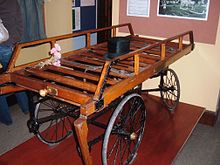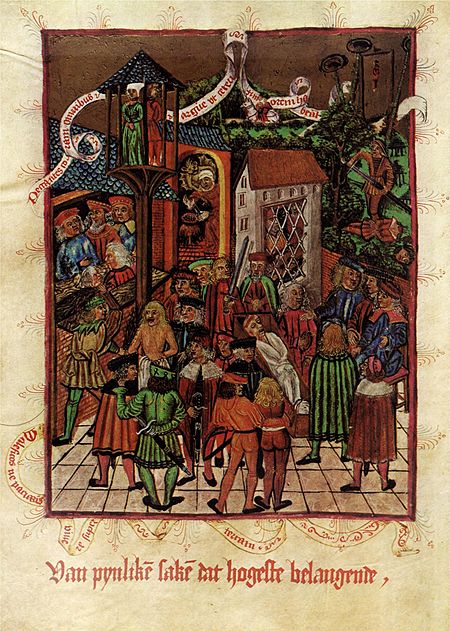Did you know that bleeding corpses were once used to solve murders? In the days before forensic science (DNA, fingerprints, blood stains), courts often relied on rituals and superstitions to determine the innocence or guilt of a suspect. One of these rituals was trial by ordeal, in which suspects were asked to undergo a dangerous trial to establish their innocence by seeking judgement from God. In some cases, they were forced to walk blindfolded on red-hot coals or ploughshares (trial by fire). In other cases, they were made to leap into a cold river to see if they would float or sink (trial by water). Societies that used trial by ordeal believed that a god or gods would protect the innocent from harm and punish the guilty. If the accused individual survived the ordeal, they were acquitted.
Another type of trial by ordeal, called cruentation (also known as the ordeal by touch, the ordeal of the bier, or the bier test – named for the type of wagon that carried a corpse or coffin), was reserved for suspected murderers. The word derives from Latin cruentatio (staining with blood) and cruentare (to make bloody). In this practice, the accused was brought before the corpse of the murder victim in the courtroom (typically within two-three days of the murder) and was instructed to put their hands on it. If the wounds of the corpse began to bleed or other unusual visual signs appeared, that was regarded as God’s verdict, announcing that the accused was guilty (sometimes the mere presence of the guilty was enough to cause the corpse to bleed). In contrast to other trials by ordeal, cruentation allowed the victim to play a part in divine justice.1 This ritual lasted in courts across Europe and colonial America from at least the 1100s to the early 1800s.2

The custom, which varied in protocol between cultures and courtrooms, was described by Robert Brittain in 1965:3
The usual procedure was as follows: the suspect was placed at a certain distance from the victim who had been laid naked on his back. He approached the body, repeatedly calling on it by name, then walked round it two or three times. He next lightly stroked the wounds with his hand. If during this time fresh bleeding occurred, or if the body moved, or if foam appeared at the mouth, the suspect was considered to be guilty of murder; if not, further evidence was sought. Sometimes the whole local population was made to pass in front of the corpse. A positive result was considered as evidence of divine intervention.

The providential nature of cruentation revealed God’s hand in uncovering sin. While many ascribed the phenomenon to a heaven-sent miracle, others suggested that God was working through natural causes. For example, some held that death was a gradual process and that dead bodies retained lingering vitality for a short period, still able to hear and act. The victim’s fury was imprinted on the body and blood, and the touch of the murderer caused the blood to flow by sympathetic action. In this way, the soul, still present in the deceased, obtained revenge, reestablishing a moral order, broken by criminal actions.4
Another explanation was that the spirits of the murderer were transmitted to the victim at the time of the homicide where they became embedded in the wound. Upon reappearance of the perpetrator, these spirits were drawn out of the wound towards the killer, carrying with them the blood of the dead. Alternatively, vital spirits were transferred between the killer and the victim at the moment of the murder, and when the offender passed close to the victim, the spirits in the former attracted the blood of the latter. As strange as these proximate mechanisms may seem to us today, they were consistent with prevailing physiological models of the time, which emphasized the blurred border between life and death, the porous boundaries of the human body and the importance of vital spirits in homeostasis.
Did people really believe that corpses bled? It seems so. Joel Harrington concluded in his chapter, The Strange Survival of the Bleeding Corpse that, “Just as obviously, many learned people before the 18th century did believe in the reality of cruentation, that is, that for some natural or supernatural reason, the bodies of murder victims genuinely bled or otherwise altered in the presence of their murderers”.5 The mere belief that cruentation was real might induce a murderer to confess or otherwise reveal himself by his reaction to being asked to take the test.
What can we make of eyewitness accounts describing blood flowing from corpses? According to Gaskill, “such miracles were neither rare, nor witnessed solely by the lower orders”.6 When bodies start to decompose, they form a foul smelling red colored liquid called purge fluid, which may leak through the nose or mouth when the body is manipulated. However, that would not explain the appearance of blood from the mortal wounds. Gaskill writes: “Despite congealment, post-mortem bleeding is medically possible but could not have occurred as dramatically as witnesses describe. The explanation must surely lie, therefore, in the fictionalization of testimony, suggesting not falsehood but… [an] altered definition of truth in early modern courts”.7
The discrediting of cruentation was a gradual process, requiring buy in from physicians and theologians alike.8 The Tuscan polymath, Girolamo Maggi (1523-1572) famously questioned the logic of the procedure: why does cruentation not occur in animals; why does it not happen to those who are killed in their sleep and are “unable to develop a desire for revenge against the killer”; why does it also occur when someone is killed at a distance, for example from a bullet wound?9
England stopped using the judicial test at the end of the 17th century, and German courts abandoned it at the end of the 18th century. There are still records of courts in the United States using cruentation until 1869.10 Cruentation outlasted other ordeals, possibly because its causes could be reinterpreted in non-supernatural terms. The practice was favored by James VI of Scotland (and future king of England) and is a popular literary topos and stage device in Elizabethan and Jacobean theater. A notable example is in William Shakespeare’s Richard III, first performed in the 1590s. During the funeral of King Henry VI, Lady Anne confronts Gloucester, the man who murdered Henry:
O! gentlemen; see, see! dead Henry’s wounds
Open their congeal’d mouths and bleed afresh.
Blush, blush, thou lump of foul deformity,
For ’tis thy presence that exhales this blood
For ’tis thy presence that exhales this blood
From cold and empty veins, where no blood dwells:
Thy deed, inhuman and unnatural,
Provokes this deluge most unnatural.
Shakespeare’s Richard III, in Act I, Scene II
One can only imagine the suspense surrounding the ritual, whether in real life or on stage. It conjures images of OJ Simpson being asked to try on the bloody gloves at his trial for murder in 1995 (with lead defense attorney urging the jurors: “if the gloves don’t fit you must acquit”). How many guilty killers were exonerated over the centuries by “passing” a trial by ordeal, and more alarmingly, how many innocent people were convicted on the basis of a “bleeding corpse”?
A consideration of the history of cruentation provides fascinating insights into the intersection of theology, law, medicine, and science during the middle ages and early modern Europe. Like other unusual chapters in history, it is a story that must be studied, judged and recounted in the context of the times.
